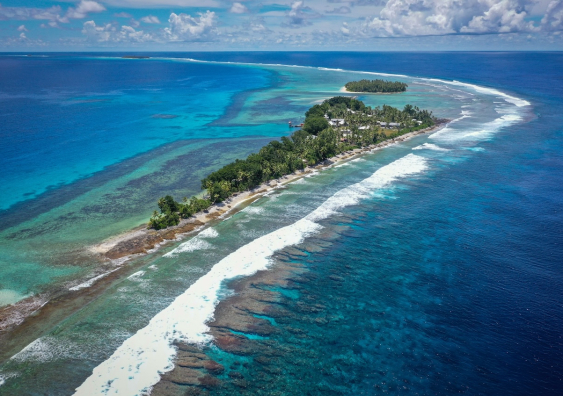A group of experts is creating guidelines on how existing refugee and human rights law principles can protect people displaced by climate change.
The impacts of climate change and disasters on the displacement of people amount to one of the biggest challenges of our time.╠ř
For the Asia-Pacific, which has experienced most of the worldÔÇÖs disaster-related movements, finding workable solutions is especially urgent. Between 2010 and 2021, there were, on average, 19 million internal displacements each year in the region,╠ř╠řof the global total.
Over the past year, Pacific leaders have demonstrated their commitment to addressing movement in the context of climate change and disasters.╠ř
In November 2023, Pacific leaders adopted the╠ř,╠řan agreement to ensure that countries in the region are able to ÔÇťanticipate, prepare for and respond to the hazardous impacts of climate change, including in relation to mobilityÔÇŁ.╠ř
At the same time, Australia and Tuvalu announced the╠ř, a treaty which provides a pathway for people from Tuvalu to migrate to Australia in the context of climate change. This is a proactive, practical approach that gives people choices about if and when they wish to move.
But more needs to be done, particularly when it comes to ensuring the legal protection of people displaced across an international border when climate change is a factor. ╠ř
That is why a group of experts is creating guidelines to show how existing refugee and human rights law principles can already provide international protection when climate change and disasters are raised as factors in displacement. ╠ř
While not everyone moving in the context of climate change is a refugee, some people are, and it is important for government officials and other decision-makers to understand why.
The impact of climate╠ř
ÔÇśÔÇÖ describes the many ways people move in the context of climate change and disasters.╠ř
Movement may be temporary or permanent, within a country or across an international border, predominantly voluntary or predominantly forced. Climate mobility encompasses internal displacement, cross-border displacement, migration, evacuations and planned relocations, as well as the notion of the so-called "climate refugee".
Where the effects of conflict, inequality, poverty, human rights violations, disasters and climate change overlap, the risks of displacement are especially acute.╠ř
Climate change does not cause╠řdisplacement on its own; nor does it cause particular disasters. Rather, it amplifies risks ÔÇö the risk of more severe and more frequent disasters and the risk of displacement.╠ř
In 2023,╠ř╠řof new internal displacements globally were linked to disasters ÔÇö about 26.4 million people. In 2019, the disparity was╠ř╠řÔÇö 75 percent of all internal displacements were disaster-related, compared to 25 percent linked to conflict.
What makes a "hazard" a "disaster" is that people lose the ability to cope. In other words, there is no such thing as a "natural" disaster: disasters depend on underlying social, economic, political and environmental factors.╠ř
It is this combination of factors that drives people to move. And when the effects of climate change are added to the mix, it may be the last straw.╠ř
In 2023, the Kaldor Centre for International Refugee LawÔÇÖs╠ř╠řwere developed as a response to these challenges.
They set out key priorities and actions to enable people to stay in their homes when they want to and itÔÇÖs safe; to help people move away from dangerous areas before disasters strike, including through migration and planned relocations; and to ensure that people are protected and assisted if they are displaced (whether internally or across an international border).
They build on a range of existing examples of intergovernmental cooperation on climate mobility, such as the╠ř╠řand AfricaÔÇÖs╠ř.
The role of refugee law
In legal terms, there is no such thing as a "climate refugee". But there are clearly people who qualify for refugee protection because the impacts of climate change or disasters worsen their predicament.╠ř
To assist legal practitioners, decision-makers and other officials adjudicating asylum claims, the Kaldor Centre, together with the Center for Gender and Refugee Studies in the US, Essex Law School and Human Rights Centre in the UK, and UNHCR, is creating a practical framework to explain how existing refugee and human rights law principles can provide international protection.
This framework complements existing high-level guidance, such as UNHCRÔÇÖs╠ř╠řfrom 2020 and a╠ř╠řfrom the Refugee Law Initiative released in June. It also builds upon╠ř╠řto the Inter-American Court of Human Rights that emphasise the role of existing legal principles in protecting people moving across borders in the context of climate change.
Detailed practical guidance is needed for a number of reasons. ╠ř
First, officials and judges considering protection claims in the context of climate change and disasters often dismiss refugee law outright. They assume, for instance, that people are simply unfortunate victims of "natural" disasters, or that there is no individual risk, because disasters are widespread and indiscriminate.╠ř
This fails to understand how climate change and disasters intersect with other drivers of displacement, and it means that people with genuine claims for international protection may be left without it.
Second, climate change and disasters can make a risk of persecution more acute, or╠ř╠ř"existing patterns of discrimination and marginalisation".╠ř
As the╠ř╠řhas emphasised, "the adverse effects of climate change and disasters are often exacerbated by other factors", such as poor governance, social disharmony or diminishing resources.
Third, beyond refugee law, the principle of╠řnon-refoulement╠řÔÇö non-removal ÔÇö in human rights law further protects people against removal to a place where their life may be at risk, or where they would face inhuman or degrading treatment. As the UN Human Rights Committee has╠ř, the impacts of climate change could expose people to these risks, "thereby triggering [StatesÔÇÖ ÔÇŽ]╠řnon-refoulement╠řobligations".
This new guidance aims to help decision-makers acquire a clearer appreciation of the scenarios in which protection needs may arise, meaning they will be more likely to understand the impacts of climate change within a broader social context.╠ř
The hope is that it will, in turn, provide the basis for the development of national-level guidelines in other countries, such as the╠ř╠řpublished by the Center for Gender and Refugee Studies in 2023 for US decision-makers.
Since the Refugee Convention came into force 70 years ago, the refugee definition has been interpreted in a dynamic way. Today it is understood as being able to encompass gender-based persecution, persecution linked to sexual orientation and identity, and a variety of other circumstances that its drafters never would have envisaged.
In that sense, there are no special tricks here ÔÇö itÔÇÖs a business-as-usual approach to refugee decision-making, properly applying the law to the facts at hand.
At the end of the day, the ultimate goal of all climate mobility interventions should be to provide people with choices to stay, or move, in safety and with dignity.
Jane McAdam AO╠řis Scientia Professor of Law and the Director of the Kaldor Centre for International Refugee Law at UNSW Sydney, and an Australian Research Council Laureate Fellow.
Originally published under╠ř╠řby╠řÔäó.







